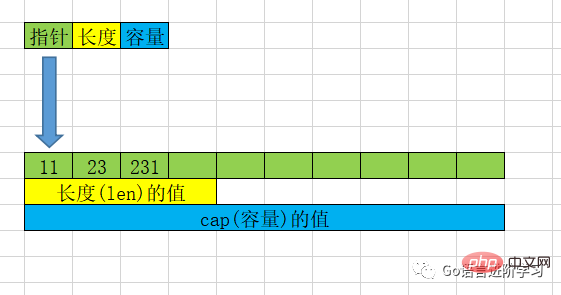
We know that we can passmake Create slices.
var names = make([]string,10,10)
This sentence means that a slice is dynamically created. The number of elements in the slice is 10, and the capacity of the slice is also 10.
Are you confused???
What are the number and capacity of slices? ? ?
What is their relationship? ? ?
In fact, slicing is, after all, a way to store data One thing, currently we know that arrays can store things.
其实切片的本质,还是数组,只不过是Go帮助我们做了一些封装,可以方便的对切片里面的数据增删改查。
例如:
package main
import "fmt"
func main() {
var names = make([]int, 4, 10)
//int类型默认值是0
fmt.Println(names, len(names), cap(names)) //结果:[0 0 0 0] 4 10
}理解图。

没错,本质就是指向了一个长一点的数组。
但是这个数组是会自动扩容的,当容量(cap)append满了之后,会自动扩容。
现在,我们就知道make里面参数的意义了。
注意:在Go中,推荐使用make创建切片,并且在创建时,需要考虑容量,尽可能不触发容量自动扩容机制,提高性能。
在上一章中,大概有这样一段代码。
package main
import "fmt"
func main() {
var names = make([]int,5,10)
names = append(names,11,23,231)
fmt.Println(names)//[0 0 0 0 0 11 23 231]
}append之后,前面会有很多0,这是怎么回事。
解释:
在通过make创建切片时,第二个参数是切片元素的数量。
上述代码切片第二个参数是5,表示在创建切片时,前5个就已经有值了,只不过是int默认值0。
所以再append时,是再原有的基础上,添加值的,直到cap满了之后,触发扩容机制。
如图所示。

现在,清晰了吧?
那怎么append时,从0开始呢???
这不是很简单,直接让第二个参数为0。
var names = make([]int,0,10) //结果:[11 23 231]
如图所示。

好了,这个,懂了吧,怎么继续哈。
我们上述一直在提一个词,自动扩容。
我们来看这样一段普通的代码。
package main
import "fmt"
func main() {
var names []int
//地址:0x0,长度(len):0,容量(cap):0
fmt.Printf("地址:%p,长度(len):%d,容量(cap):%d\n", names, len(names), cap(names))
names = append(names, 1, 2, 3)
//地址:0xc000010380,长度(len):3,容量(cap):4
fmt.Printf("地址:%p,长度(len):%d,容量(cap):%d\n", names, len(names), cap(names))
}虽然按照这种方法,使用append动态添加是没问题的。
在不使用make声明数组时,len和cap都是0,并且地址也是一个值。
通过append之后,可以明显看到,地址发生了改变,因为又重新申请了数组,切片重新指向新的数组。
len和cap也发生了变化。
package main
import "fmt"
func main() {
var names1 = make([]string, 0, 10)
names1 = append(names1, "张三")
names1 = append(names1, "李四")
var names2 = names1 //将names1赋值到names2
fmt.Println(names1, names2) //[张三 李四] [张三 李四]
names1[0] = "张三666"//修改names下标为0的值为 张三666
fmt.Println(names1, names2) //[张三666 李四] [张三666 李四]
//为什么修改names1的值,会影响names2的值????
}为什么修改names1的值,会影响names2的值???
This brings us back to the memory distribution diagram, as shown in the figure.

We have said many times that whether it is printing or assignment, we will only operate the stackThe value stored above .
When names2=names1, only names1The address on the stack is given to names2.
But when saving, the address on the heap still points to the same heap.
So when modifying names1, names2 has also been modified.
What if you don’t want the above problems to occur???
Solution: Use copy
package main
import "fmt"
func main() {
var names1 = make([]string, 0, 10)
names1 = append(names1, "张三")
names1 = append(names1, "李四")
//定义一个names2切片用于接收,第二个参数要留空间,names1里面又几个元素,names2第二个参数也要是几
var names2 = make([]string, 2, 10)
copy(names2, names1)//将names1的值,赋值到names2
fmt.Println(names1, names2) //[张三 李四] [张三 李四]
names1[0] = "张三666"//修改names下标为0的值为 张三666
fmt.Println(names1, names2) //[张三666 李四] [张三 李四]
fmt.Printf("names1地址:%p names2地址:%p\n",names1,names2)
//names1地址:0xc00009a0a0 names2地址:0xc00009a140
}内存图

非常抱歉,我不会。。。
The above is the detailed content of An article to help you understand the basics of Go language and slicing supplement. For more information, please follow other related articles on the PHP Chinese website!
 Usage of Type keyword in Go
Usage of Type keyword in Go
 How to implement linked list in go
How to implement linked list in go
 What are the Go language programming software?
What are the Go language programming software?
 How to learn go language from 0 basics
How to learn go language from 0 basics
 What are the methods to implement operator overloading in Go language?
What are the methods to implement operator overloading in Go language?
 What are the operators in Go language?
What are the operators in Go language?
 Network Topology
Network Topology
 notepad++ official website
notepad++ official website
 Introduction to the function of converting uppercase to lowercase in Python
Introduction to the function of converting uppercase to lowercase in Python